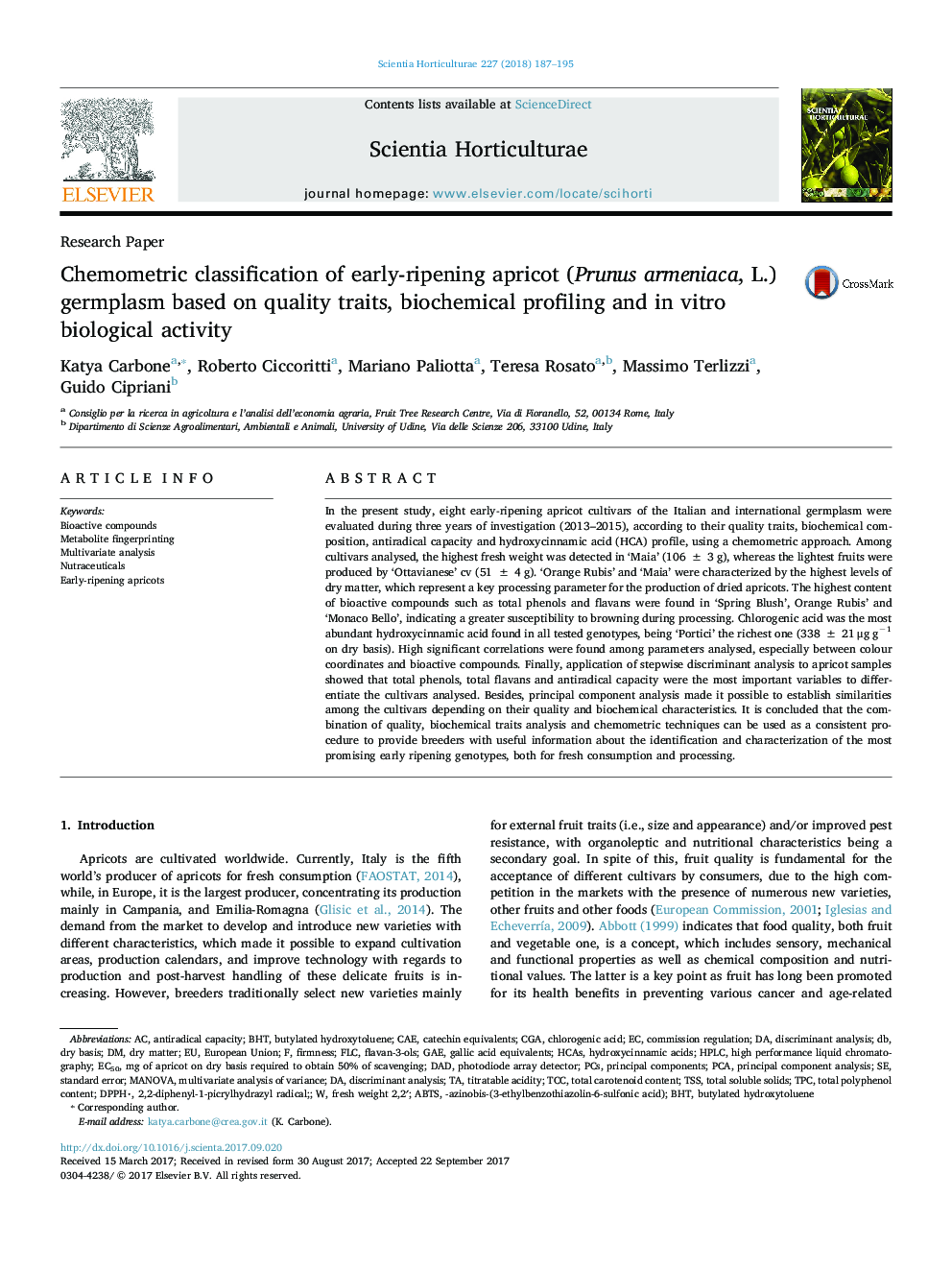| کد مقاله | کد نشریه | سال انتشار | مقاله انگلیسی | نسخه تمام متن |
|---|---|---|---|---|
| 5769470 | 1628771 | 2018 | 9 صفحه PDF | دانلود رایگان |
عنوان انگلیسی مقاله ISI
Chemometric classification of early-ripening apricot (Prunus armeniaca, L.) germplasm based on quality traits, biochemical profiling and in vitro biological activity
دانلود مقاله + سفارش ترجمه
دانلود مقاله ISI انگلیسی
رایگان برای ایرانیان
کلمات کلیدی
DPPHCAETPCTCCFlavan-3-olsCGAABTSBHTTSSGAEFLCEC50HCAsDAD2,2-diphenyl-1-picrylhydrazyl radical - 2،2-دیفنیل-1-پریکیل هیدرازیل رادیکالPCA - PCAPhotodiode array detector - آشکارساز آرایه PhotodiodeEuropean Union - اتحادیه اروپاMetabolite fingerprinting - اثر انگشت متابولیتیPrincipal components - اجزای اصلیFirmness - استحکامChlorogenic acid - اسید کلروژنیکgallic acid equivalents - اسید گالیک اسید معادلHydroxycinnamic acids - اسیدهای هیدروکسین کینیکtitratable acidity - اسیدیته قابل تیتراسیونMANOVA - انتخاب کنیدDiscriminant analysis - تجزیه و تحلیل دائمیmultivariate analysis of variance - تجزیه و تحلیل چند متغیره واریانسPrincipal component analysis - تحلیل مولفههای اصلی یا PCAMultivariate analysis - تحلیل چندمتغیرهBioactive compounds - ترکیبات بیولوژیکیdry basis - خشک کردن پایهstandard error - خطای استانداردPCs - رایانه های شخصیAntiradical capacity - ظرفیت ضد انعقادیdry matter - ماده خشکcatechin equivalents - معادله کاتچینTotal polyphenol content - مقدار کل پلی فنلtotal carotenoid content - مقدار کل کاروتنوئیدNutraceuticals - نوتراسوتیکال، غذاهای فراسودمندbutylated hydroxytoluene - هیدروکسی تورولین باتلاقیhigh performance liquid chromatography - کروماتوگرافی مایع با کارایی بالاHPLC - کروماتوگرافی مایعی کاراtotal soluble solids - کل مواد جامد محلول
موضوعات مرتبط
علوم زیستی و بیوفناوری
علوم کشاورزی و بیولوژیک
دانش باغداری
پیش نمایش صفحه اول مقاله

چکیده انگلیسی
In the present study, eight early-ripening apricot cultivars of the Italian and international germplasm were evaluated during three years of investigation (2013-2015), according to their quality traits, biochemical composition, antiradical capacity and hydroxycinnamic acid (HCA) profile, using a chemometric approach. Among cultivars analysed, the highest fresh weight was detected in 'Maia' (106 ± 3 g), whereas the lightest fruits were produced by 'Ottavianese' cv (51 ± 4 g). 'Orange Rubis' and 'Maia' were characterized by the highest levels of dry matter, which represent a key processing parameter for the production of dried apricots. The highest content of bioactive compounds such as total phenols and flavans were found in 'Spring Blush', Orange Rubis' and 'Monaco Bello', indicating a greater susceptibility to browning during processing. Chlorogenic acid was the most abundant hydroxycinnamic acid found in all tested genotypes, being 'Portici' the richest one (338 ± 21 μg gâ1 on dry basis). High significant correlations were found among parameters analysed, especially between colour coordinates and bioactive compounds. Finally, application of stepwise discriminant analysis to apricot samples showed that total phenols, total flavans and antiradical capacity were the most important variables to differentiate the cultivars analysed. Besides, principal component analysis made it possible to establish similarities among the cultivars depending on their quality and biochemical characteristics. It is concluded that the combination of quality, biochemical traits analysis and chemometric techniques can be used as a consistent procedure to provide breeders with useful information about the identification and characterization of the most promising early ripening genotypes, both for fresh consumption and processing.
ناشر
Database: Elsevier - ScienceDirect (ساینس دایرکت)
Journal: Scientia Horticulturae - Volume 227, 3 January 2018, Pages 187-195
Journal: Scientia Horticulturae - Volume 227, 3 January 2018, Pages 187-195
نویسندگان
Katya Carbone, Roberto Ciccoritti, Mariano Paliotta, Teresa Rosato, Massimo Terlizzi, Guido Cipriani,